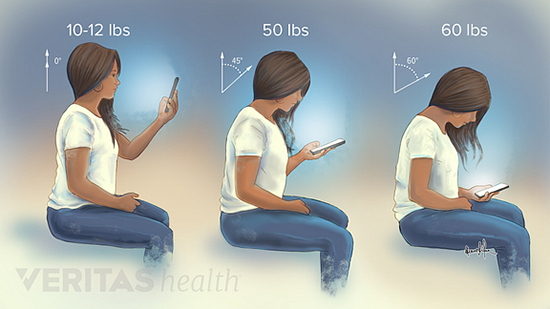Has constant neck and shoulder pain, and an underlying feeling of stress become the ‘norm’ for you? With most of us hooked to our smartphones for 2 – 4 hours a day it’s not surprising (Institute of Health and Nursing Australia).
Neck and shoulder discomfort, and consequent stress from muscle tension are most likely the result of ‘text neck’, or ‘tech neck’. Smartphones create all kinds of secondary myofascial problems, as well as well as exacerbating pre existing tensions and injuries (stiff neck and shoulders). Postural imbalances and the chain-reaction of muscular overuse/fatigue caused by phone use/overuse is something physical therapists are dealing with everyday.
This is not surprising as an average head weighs between 4.5 – 6kgs, and when tilted forward exerts a force of approximately 27 kgs (or the weight of giving a small child a piggyback ride!) (More than a Physio).
But what is ‘text neck syndrome’ exactly? It “is the term associated with the damage and pain that is sustained from constantly hanging your neck down to look at your cell phone or tablet” (Institute of Health and Nursing Australia).
Stable Remedial Massage Therapist Konrad explains:
“The interesting thing is that, if you engage in stressful content while using your smartphone on a low angle, you raise your shoulders, tense the chest and hold your breath, which increases your anxiety and stress levels. This is an automatic, physical response to using this technology.
However, you are also using muscular tension to continue performing the physical task of holding the smartphone up in space, at that angle, with the head tilted – so the double-whammy is you create more trigger points & fatigue within the muscles and tendons, on top of the headache-causing stress, anxiety and physical discomfort it has caused, as well as the fact that your peripheral senses and awareness disappear”.
Experts at spine-health.com outline strategies for both text neck treatment and prevention, and neck pain treatment and prevention; both relevant for smartphone overuse.
Neck Pain Treatment
Self Care
If neck pain is not persistent or debilitating and isn’t caused by trauma, the pain can be treated with self care:
- A short period of rest from strenuous activities and movements, with some movement encouraged to prevent the neck from becoming weaker or stiffer.
- Applying ice and/or heat for 15 – 20 mins, with at least a 2 hour break. Ice can be applied to help reduce swelling and pain. Heat application can help relax muscles, while bringing more blood flow and healing nutrients to the area.
- Gentle stretches. Some forms of neck pain and muscle tightness are greatly alleviated with gentle ROM (Range of Movement) stretches. If you find a stretch exacerbates the pain, never force it, stop and try another one. Check out these ‘4 Easy Stretches for a Stiff Neck’.
Physical Therapy
Persistent neck pain typically requires physical therapy to improve neck strength and flexibility. The treatment plan depends on the diagnosis, with prescribed exercises to continue at home.
Text Neck: Prevention and Treatment
Spine-health.com clearly outlines some adjustments to prevent text neck pain:

Raise your phone to eye-level when texting or reading.
”
- Raise the phone. Move the phone (and other devices) up closer to eye level so the head does not have to be tilted forward.
- Take frequent breaks. Spend some time away from the phone—or any type of head-forward posture. If needed, use an alarm or app to set automatic reminders to take breaks from handheld devices.
- Stand up straight. Good posture, with the chin tucked in and shoulders pulled back, keeps the body aligned in a neutral position.
See Posture to Straighten Your Back - Arch and stretch. Arch the neck and upper back backward periodically to ease muscle pain.
See Neck Stretches - Exercise regularly. A strong, flexible back and neck are more able to handle extra stress. Some research indicates that teenagers who are active in low-impact team sports or endurance sports are less likely to have neck pain.
In general, finding ways to keep the neck and body more active, rather than hunched over a mobile device, is best for the spine. For example, try scheduling just a few times per day to check text messages and emails, rather than responding multiple times per hour. ”
If ‘text neck’ is beginning to bother you, discuss your issues and an ongoing treatment plan (including home exercises between appointments) with your remedial massage therapist. A single appointment will most likely provide immediate relief but there is no magic bullet for chronic aches and pains. Long term improvements will happen only with ongoing therapy and an active treatment plan.
Book an appointment with a therapist today on 03 8598 9804 or online.